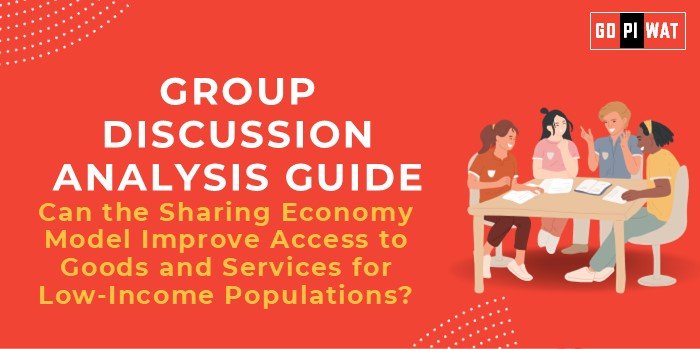📋 Group Discussion (GD) Analysis Guide: Can the Sharing Economy Model Improve Access to Goods and Services for Low-Income Populations?
🌍 Introduction to the Topic
- 💡 Opening Context: The sharing economy, characterized by platforms like Uber, Airbnb, and Swiggy, represents a shift from ownership to access. It holds potential for reducing costs and increasing accessibility, which is critical for low-income populations.
- 📜 Topic Background: Emerging in the 21st century, the sharing economy leverages underutilized assets, technology, and a gig workforce to democratize access. With an estimated $335 billion valuation by 2025, it raises questions about inclusivity and sustainability.
📊 Quick Facts and Key Statistics
- 🌍 Global Market Size: Expected to exceed $335 billion by 2025 (PwC).
- 🚗 Access Improvement: Shared mobility reduces commute costs by 20–40% in urban areas (OECD).
- 📱 Digital Adoption: 900 million+ internet users in India (MeitY 2024).
- 👥 Employment Impact: Over 1.5 million gig workers in India are engaged in sharing economy platforms.
👥 Stakeholders and Their Roles
- 🏛️ Governments: Provide regulatory frameworks and ensure fair labor practices.
- 🚀 Private Companies: Innovate platforms and expand services to underserved areas.
- 👥 Users: Participate as consumers and providers, driving demand and supply.
- 🤝 NGOs: Advocate for inclusivity, digital literacy, and fair access policies.
🏆 Achievements and ⚠️ Challenges
Achievements:
- ✅ Cost Efficiency: Platforms like Uber Pool and shared housing have lowered costs for users.
- 📈 Job Creation: Gig platforms provide income opportunities, employing millions globally.
- 🌍 Increased Access: Remote areas gain services through shared logistics and mobility models.
Challenges:
- ⚠️ Digital Divide: Rural and low-income populations may lack digital access.
- 💬 Exploitation Risks: Gig workers face wage insecurity and lack of benefits.
- 📋 Regulatory Concerns: Balancing innovation and user protection remains complex.
Global Comparisons:
- 🇪🇪 Success: Estonia’s sharing economy integrates public services with private platforms.
- 🇪🇺 Challenges: Regulatory conflicts in the EU have limited expansion in certain sectors.
Case Study:
- 🇮🇳 Rajasthan’s Shared Mobility Model: Increased rural access to affordable transportation through partnerships with ride-hailing platforms.
📋 Structured Arguments for Discussion
- 📈 Supporting Stance: “The sharing economy reduces costs, expands access, and provides flexible earning opportunities, benefiting low-income groups.”
- 📉 Opposing Stance: “Unequal access to digital tools and exploitation of gig workers limit the sharing economy’s inclusivity for low-income populations.”
- ⚖️ Balanced Perspective: “While the sharing economy increases access, its benefits are skewed toward urban, digitally literate users, requiring targeted interventions for inclusivity.”
💡 Effective Discussion Approaches
- 📊 Opening Approaches:
- 📈 “The global sharing economy market is set to grow to $335 billion by 2025, but how much of this benefits low-income groups?”
- 🌐 “While sharing platforms democratize access, their reliance on digital infrastructure excludes many low-income populations.”
- 🔍 Counter-Argument Handling:
- 💬 Example: Address concerns about gig worker exploitation by discussing regulation frameworks like California’s Assembly Bill 5.
🔍 Strategic Analysis of Strengths and Weaknesses
- ✨ Strengths: Cost efficiency, job creation, environmental benefits.
- ⚠️ Weaknesses: Digital divide, worker exploitation.
- 🚀 Opportunities: Public-private partnerships, rural digital inclusion.
- ⛔ Threats: Regulatory pushback, market saturation.
📘 Connecting with B-School Applications
- 📚 Real-World Applications: Designing inclusive business models in sharing economy startups.
- 💬 Sample Interview Questions:
- 🔎 “What are the regulatory challenges for sharing economy platforms in India?”
- 🔎 “How can public policy address digital inclusion in the sharing economy?”
- ✨ Insights for B-School Students: Explore scalable business models that integrate underserved communities.


